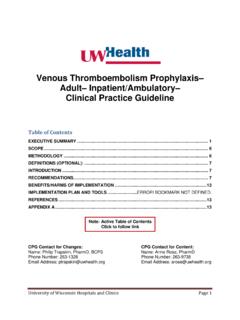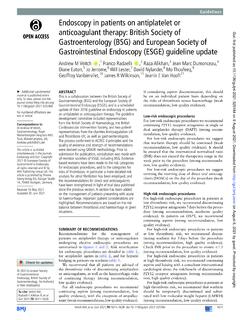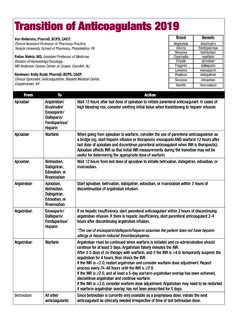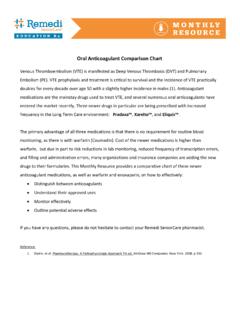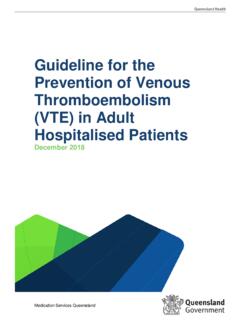Transcription of Anticoagulation Desktop Reference
1 Anticoagulation Toolkit (Version ). A Consortium-Developed Quick Reference for Anticoagulation This toolkit was produced by the Michigan Anticoagulation Quality Improvement Initiative (MAQI2), a consortium of Anticoagulation clinics and experts from across the state of Michigan. Funding for MAQI2 is provided by Blue Cross Blue Shield of Michigan and Blue Care Network through the Collaborative Quality Improvement (CQI) program. The goal of this toolkit is to provide practitioners with an up-to-date, reliable, and easy to use source of information for Anticoagulation . The content is based on the latest available evidence-based guidelines and research whenever possible. If you are aware of new guidelines or research, or if you have suggestions that can help improve this toolkit, please email us to let us know. What's new in version Added a new section for Anticoagulation in special populations, including information on AF and VTE.
2 In pregnancy and patients requiring multiple anti-thrombotic therapy Added a new section on drug-drug and drug-natural supplement interactions with DOACs Added information on warfarin reversal Numerous other updates based on the latest CHEST, AHA/ACC, ASH, and AC Forum guidelines Disclaimer: This toolkit is for informational purposes only and does not, itself, constitute medical advice. The toolkit is not a replacement for careful medical judgments by qualified medical personnel. There may be information in the toolkit that does not apply to or may be inappropriate for the medical situation at hand. Table of Contents (push Ctrl+F to search entire document for a keyword). Determining need and evaluating risk anticoagulant selection Atrial fibrillation risk evaluation tools FDA approved oral anticoagulants, indications, Stroke risk evaluation in A-fib patients (p.)
3 1) and dosages (p. 5). Bleeding risk evaluation (p. 2) Nonvalvular atrial fibrillation definitions (p. 11). Comparison of anticoagulants (p. 12). venous thromboembolism (VTE) risk evaluation anticoagulant selection based on patient tools factors (p. 14). Bleeding risk evaluation (p. 3) Identifying patients appropriate for DOACs (p. 18). Other risk evaluation models Pros and cons of DOACs (p. 19). Bleeding risk models (p. 4) anticoagulant selection decision tree ( ). Online calculators and apps ( ). Warfarin DOACs Initiation Initiation Things to consider before starting pt on DOAC initiation checklist ( ). warfarin (p. 21) ICHECK'D Mnemonic for DOAC initiation (p. 54). Target INR and length of treatment (p. 22) Converting from other anticoagulants (p. 59). Starting dose (p. 26) Length of Treatment for VTE (p. 24). Initial dosing nomograms (p.
4 28) Initial VTE treatment setting (p. 30). Initial VTE treatment setting (p. 30) Drug-Drug/Supplement interactions (p. 56). Converting from DOAC to warfarin (p. 31) Patient education Drug-Drug interactions (p. 32) Education topic checklist (p. 60). Patient education Education materials (p. 61). Education topic checklist (p. 33) Long-term management Education materials (p. 34) Routine follow-up checklist (p. 62). Long-term management DOAC Management Plan Flowchart (p. 63). Maint. dosing and recall nomogram (p. 35) Periprocedural management (p. 64). Periprocedural management (p. 37) Measurement and reversal (p. 69). Elective Cardioversion (p. 41) Bleeding management (p. 70). Managing interactive drugs (p. 44) Converting to other anticoagulants (p. 75). Routine follow-up questions (p. 46) DOAC Patient Cards ( ). Patient self-management (p.
5 47) Minor bleeding on anticoagulants (p. 48). Minor bleeding on anticoagulants (p. 48) Epistaxis management protocol (p. 49). Epistaxis management protocol (P. 49) Restarting Anticoagulation after bleed (p. 52). Warfarin reversal ( ). Restarting Anticoagulation after bleed (p. 52). Special Populations AF in pregnancy (p. 83) anticoagulant -Antiplatelet combo tx (p. 88). VTE in pregnancy (p. 85). Other Information Quality Improvement tools (p. 77) Anticoagulation Links (p. 90). Bleeding/Clotting Risk Evaluation Tools for Atrial Fibrillation Patients Before prescribing anticoagulants, providers should weigh the risk of thrombosis against the risk of bleeding. The tools below can be used to help providers and patients make informed decisions about whether or not Anticoagulation is warranted. Stroke Risk Scores CHA2DS2-VASc The CHA2DS2-VASc score is an expansion of the original CHADS2 score to include 3 additional stroke risk factors: age 65- 74, female sex, and history of vascular disease.
6 The additional risk factors are believed to more accurately determine stroke risk and the need for Anticoagulation in patients with CHADS2 scores of 0 or 1. The CHA2DS2-VASc is recommended over CHADS2 since the 2014 AHA/ACC/HRS Atrial Fibrillation CHA2DS2-VASc Scoring Tool2 Score Risk AHA/ACC/HRS Guidelines1. Condition Points Congestive heart failure 1. 3 High Anticoagulate (men and women). Hypertension 1. Age > 75 years 2 High (men) Anticoagulate (men). 2. Diabetes mellitus 1 Intermediate (women) Consider Anticoagulation (women). Stroke/TIA or thromboembolism 2 Intermediate (men). 1 Consider Anticoagulation (men). (prior) Low (women). Vascular disease (MI, PAD, or aortic 1 Reasonable to omit 0 Low plaque) Anticoagulation Age 65-74 years 1. Sex Category (Female) 1. Total score=. CHA2DS2-VASc Yearly Stroke Risk (%) Aspirin alone or in combination with Score another antiplatelet (eg.)
7 Clopidogrel) is No Warfarin With Aspirin4 With Warfarin4 no longer recommended for stroke 0 0 0 0 prevention in atrial fibrillation 1 2 3 4 5 6 1 January CT, et al. 2019 AHA/ACC/HRS focused update of the 2014 AHA/ACC/HRS guideline for the management of patients with atrial fibrillation. Circulation. 2019;139:e000 e000. DOI: 2 Lip GY, Nieuwlaat R, Pisters R, Lane DA, Crijns HJ. Refining clinical risk stratification for predicting stroke and thromboembolism in atrial fibrillation using a novel risk factor-based approach: the euro heart survey on atrial fibrillation. Chest. 2010 Feb;137(2):263-72. doi: 3 Camm, AJ et al. 2012 focused update of the ESC Guidelines for the management of atrial fibrillation. European Heart Journal (2012)33, 2719 . 2747. doi: 4 Robert G. Hart, MD; Lesly A. Pearce, MS; and Maria I. Aguilar, MD. Meta-analysis: Antithrombotic Therapy to Prevent Stroke in Patients Who Have Nonvalvular Atrial Fibrillation.
8 Ann Intern Med. 2007;146:857-8673. 5 Lipp G, et al. Antithrombotic Therapy for Atrial Fibrillation CHEST Guideline and Expert Panel Report. CHEST 2018; 154(5):1121-1201. Copyright 2014-2019, MAQI2 For questions or permissions, please email Version , reviewed/updated 10/8/19 Return to TOC Page 1. Bleeding Risk Scores Bleeding risk should be assessed at each patient contact and should initially focus on potentially modifiable risk factors. The HAS-BLED tool can be used to identify modifiable risk factors (in red). Patients with scores indicating high bleed risk ( 3) should be followed more HAS-BLED Score (warfarin in atrial fibrillation patients)2. Estimates risk of major bleeding for patients on warfarin for atrial fibrillation. Condition Points Total Annual Intracranial Major bleed H Hypertension 1 Points Major bleed bleeds per risk category A Abnormal renal/liver function (1 pt 1 or 2 risk (%) 100-pt-yrs3.)
9 Each) 0 Low 1 Low S Stroke 1 2 Intermediate B Bleeding history or disposition 1 3 High L Labile INRs 1 4 High E Elderly 1 5 High D Current drugs (medication) or 1 or 2. alcohol use (1pt each). TOTAL POINTS. Modifiable risk factors in red. When evaluating the risk/benefit of Anticoagulation in atrial fibrillation, it is important to consider the risks of ischemic stroke, intracranial hemorrhage and extracranial hemorrhage independently. Condition Definition Hypertension Systolic Blood Pressure >160. Abnormal renal function Chronic dialysis, renal transplantation, serum creatinine 200 mol/L, or CrCl<50. Abnormal liver function Chronic hepatic disease/biochemical evidence of hepatic derangement (eg, bilirubin >2 upper limit of normal, with AST/ALT/Alk Phos >3 upper limit normal). Stroke Any previous history of Stroke Bleeding history or Bleeding event history (defined below), genetic predisposition, anemia.
10 Disposition Labile INRs <60% of time spent in therapeutic INR range (INR 2-3). Elderly Age 65 years Current medication or Concomitant use of antiplatelet agent/aspirin, NSAIDs, or alcohol >16. alcohol use beers/week, >10 glasses wine/week or equivalent Bleeding event Bleeding requiring hospitalization and/or causing a decrease in Hgb>2g/dL and/or requiring 2 unit blood transfusion. 1 Lipp G, et al. Antithrombotic Therapy for Atrial Fibrillation CHEST Guideline and Expert Panel Report. CHEST 2018; 154(5):1121-1201. Copyright 2014-2019, MAQI2 For questions or permissions, please email Version , reviewed/updated 10/8/19 Return to TOC Page 2. 2 Pisters R, Lane DA, Nieuwlaat R, de Vos CB, Crijns HJ, Lip GY. A novel user-friendly score (HAS-BLED) to assess 1-year risk of major bleeding in patients with atrial fibrillation: the Euro Heart Survey.

